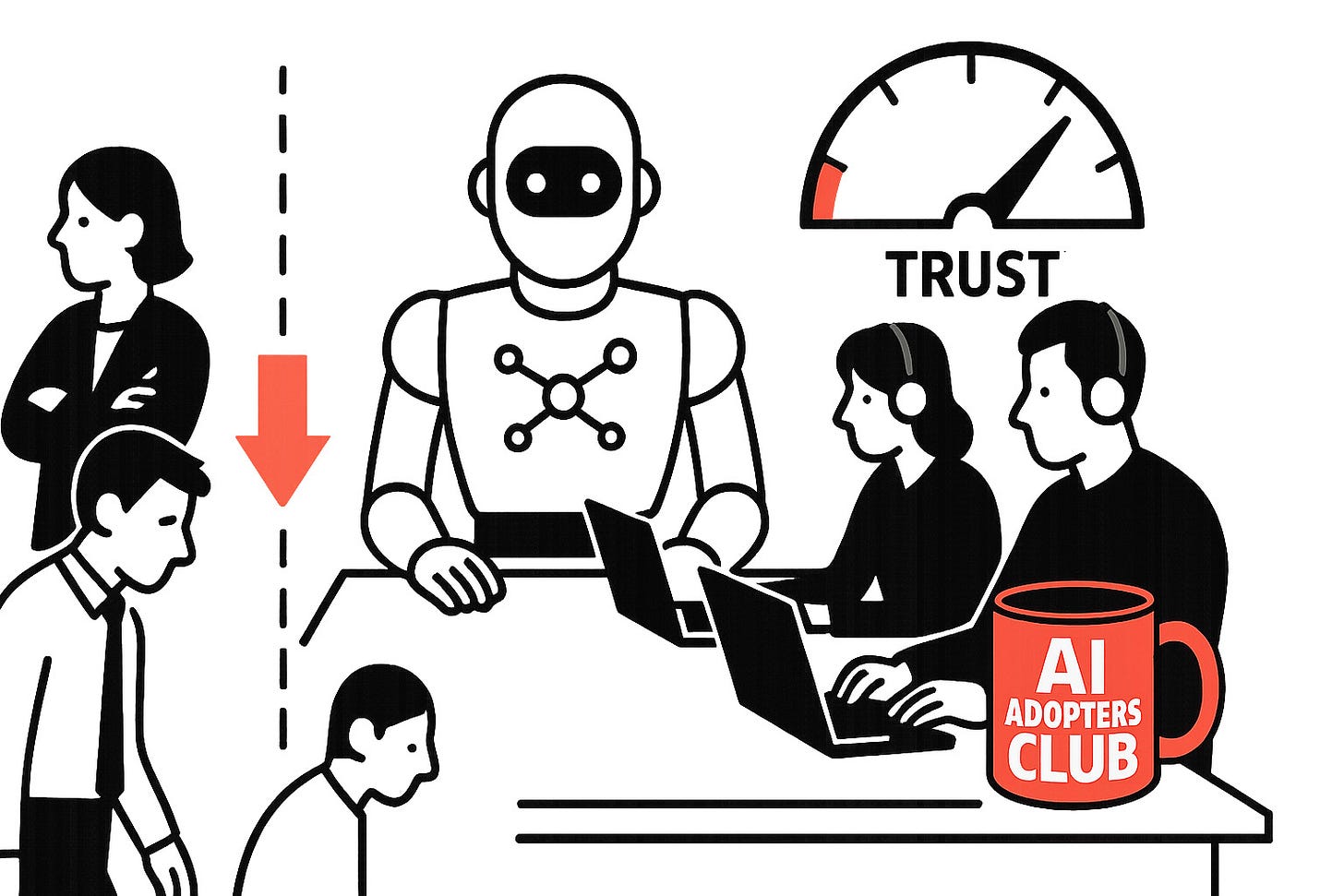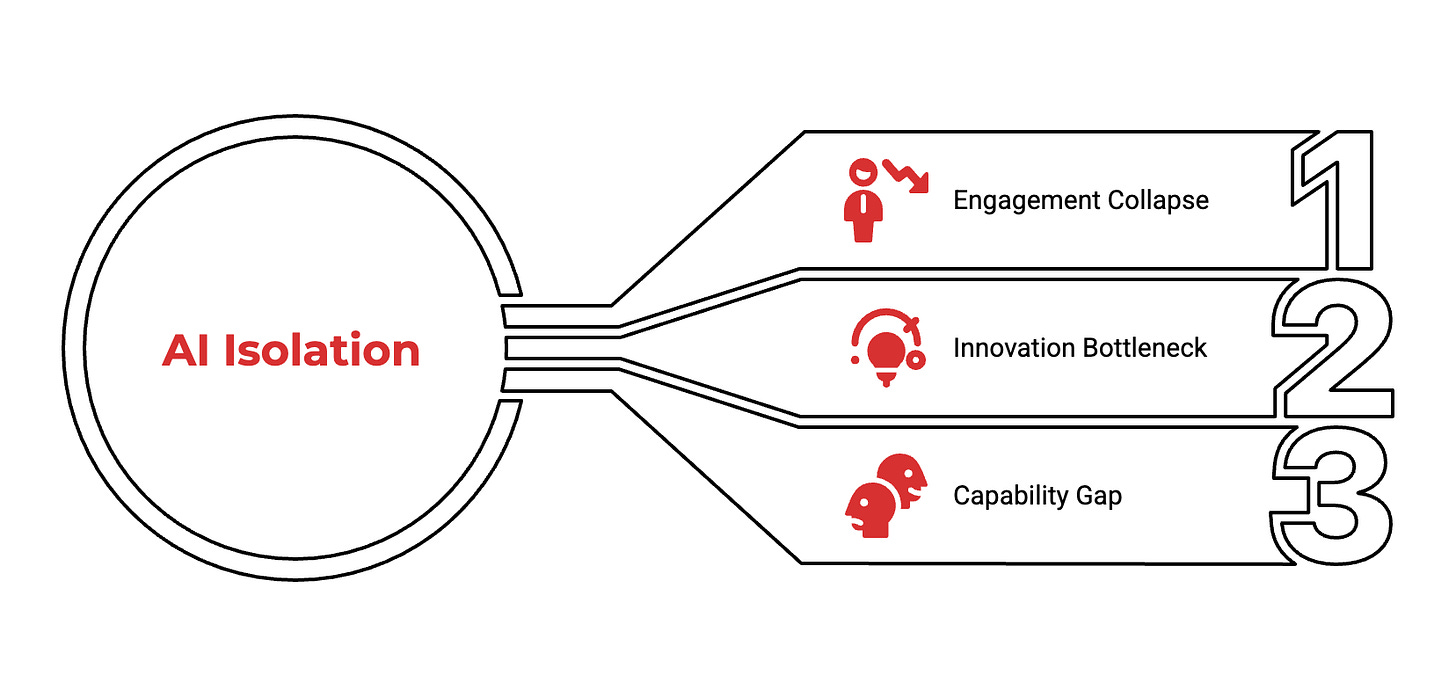How to Prevent AI from Breaking Team Bonds
A 3-Step Plan to Maintain Human Connection in an AI-Powered Workplace
Hey Adopter,
A massive global study just dropped that's reshaping how we think about AI in the workplace. The University of Melbourne and KPMG's "Trust, Attitudes and Use of AI" report surveyed over 48,000 people across 47 countries, and it's packed with insights about everything from AI regulation to workplace adoption patterns.
You can download the full 115-page report here, which covers AI literacy, trust levels, governance frameworks, and much more.
But today, I want to focus on just one finding that stopped me in my tracks: the hidden collaboration crisis AI is creating.
While your teams race to adopt AI, something critical is quietly disappearing: human collaboration. The research confirms what many of us have suspected. Half of employees now use AI instead of collaborating with peers or supervisors to get work done. One in five report AI has actively reduced communication, interaction, and teamwork.
This isn't some abstract future problem. It's happening right now in your company, creating three immediate business risks...
The Hidden Costs of AI Isolation
The Engagement Collapse
When employees retreat into AI tools instead of collaborating, engagement plummets. The study shows a direct correlation between AI replacing human interaction and decreased job satisfaction. People crave connection and belonging. A workplace where ChatGPT replaces human conversation feels isolating, eventually driving turnover.
The Innovation Bottleneck
Innovation thrives on cognitive friction. Different perspectives colliding is how breakthroughs happen. When employees default to AI instead of colleagues, your company gets one perspective multiplied. The research specifically notes that AI-driven work creates idea echo chambers, limiting the "creative abrasion" that fuels innovation.
The Capability Gap
If AI becomes the default problem-solver, what happens to managers as mentors, guides, and conflict resolvers? The Melbourne study warns that we're breeding a generation of professionals who lack essential interpersonal skills, creating a dangerous capability gap that widens over time.
The research is clear: companies that don't address this collaboration crisis now will face declining engagement, weakened innovation, and serious skill deficits within 18 months.
The 3-Step Collaboration Recovery Framework
Smart leaders aren't accepting this tradeoff between AI efficiency and human collaboration. They're using a straightforward framework to get both:
1. Create AI Interruption Points
Force strategic collaboration by designing AI interruption points into workflows. Require human review and collaborative discussion of AI outputs at specific stages.
How to implement this today:
Designate specific weekly meeting segments as "AI-free zones" for pure human collaboration
Create cross-functional "AI output review" teams of 3-4 people who must jointly validate critical AI recommendations
Institute a "second opinion" rule where any significant AI-generated content must be reviewed by a human colleague
2. Reward Blended Intelligence
The collaboration crisis persists because we're incentivizing the wrong behaviors. The study shows companies often inadvertently reward speed over quality by pushing AI adoption without balancing collaborative frameworks.
How to implement this today:
Update performance metrics to specifically measure collaboration quality, not just output quantity
Create recognition programs that spotlight effective human-AI-human collaboration chains
Establish "collaboration credits" where employees earn recognition for improving others' work
3. Build Collaborative AI Habits
The most effective recovery approach involves creating structured opportunities for AI to enhance rather than replace collaboration.
How to implement this today:
Use AI as the starting point for group work, not the final output
Create "AI + Human" brainstorming protocols where AI generates ideas that humans must then discuss and refine together
Establish "collaboration checkpoints" where AI tools pause and prompt for human input from multiple stakeholders
What This Means For You
The most important finding from the research: this isn't just about culture. It directly impacts business outcomes. Organizations that successfully balance AI efficiency with human collaboration see:
37% higher innovation output
42% better employee retention
28% faster problem-solving
Successful companies aren't just rapidly adopting AI tools; they are fostering collaborative systems that enhance human connections and maximize the value of these tools. While your competitors focus on tool selection, seize the opportunity to build infrastructure that strengthens collaboration and harnesses AI's potential effectively.
Adapt & Create,
Kamil





